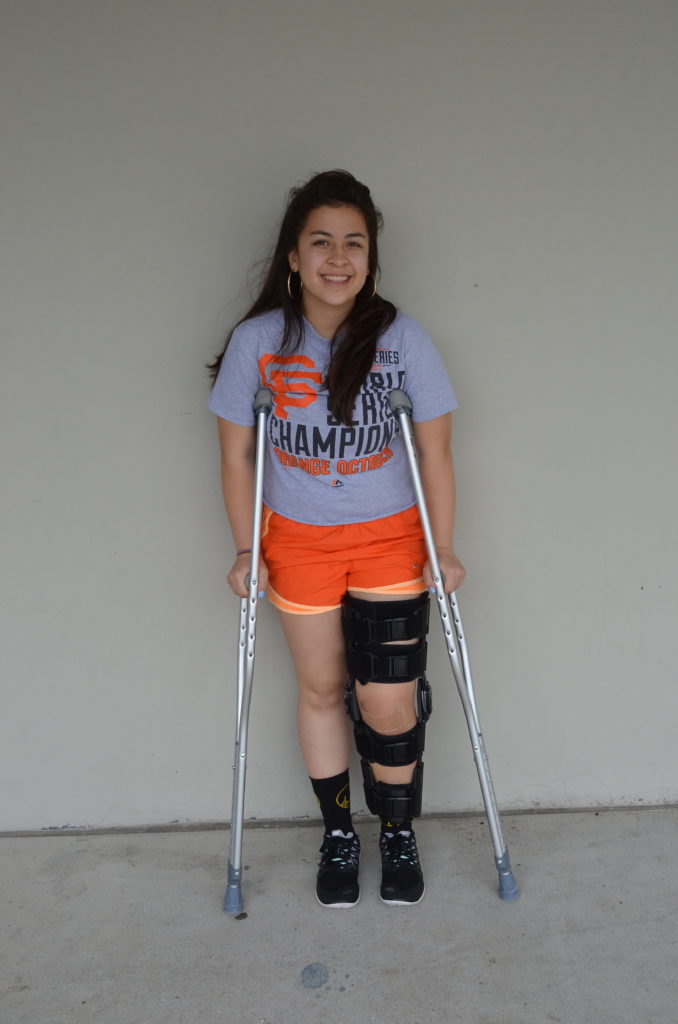Ever since Title IX was passed in 1972, the number of girls participating in high school sports has increased dramatically, by more than 900%. As the number of athletes rises, the number of injuries increases simultaneously.
The most common injury for high school athletes is tearing their anterior cruciate ligament, commonly known as their ACL. Approximately 20,000 to 80,000 high school athletes tear their ACL a year, with the majority of these athletes being girls.
What actually is an ACL injury? The ACL is one of four knee ligaments that joins the upper leg bone with the lower leg bone. The ACL keeps the knee stable, controlling how far forwards the tibia, the shin bone, can slide. It prevents your knee from bending sideways towards your body. When someone has an ACL injury, it means that their ACL becomes stretched out, the ligament is close to splitting or it means that it has split into two pieces and the knee joint is unstable. These injuries usually result from contact with an outside force, cutting movements, sudden changes in direction, unanticipated changes in direction of the play and landing from a jump with inadequate knee and hip flexion.
Typically sports that involve cutting, planting and changing direction put athletes at greater risk of an ACL injury. Athletes who participate in soccer, basketball, volleyball, tennis and other similar sports are more prone to injuries than runners, bikers, and swimmers because those athletes participate in more linear sports.
Although any athlete can injure their knee, female athletes are four to six times more likely than male athletes. Sabrina San Diego, a volleyball, basketball, lacrosse player and dancer, describes how her ACL injury felt; “like my knee went straight into the side of my left thigh. My thigh and calf went two different ways! It was extremely painful immediately following the collision, so I fell to the ground and started crying. Soon enough my knee swelled up.” San Diego has been going to physical therapy and is heading off to have surgery soon. She states “ I’ll be out for nine months to a year. The likelihood of me playing at the collegiate level isn’t very likely but I’ll probably play intramural basketball, club volleyball and lacrosse.”
Knee injuries are the most common cause of permanent disability for female high school basketball and soccer players.They account for up to 91% of season-ending injuries and 94% of injuries requiring surgery.
Although female athletes are statistically known to be more prone to injury, researchers have suggested multiple reasons for this problem. Dr. James Chen, a sports medicine surgeon specializing in minimally invasive arthroscopic techniques for the knee, states that “at the moment, many reasons have been proposed for this difference between men and women, including the differences in pelvis width and the shape of the thigh bone structure, hormonal changes that occur with maturation and muscular factors that regulate the way the muscles around the knee function to protect the joint.”
In addition to structural differences between male and female athletes, Dr. Chen reports, “boys tend to land and cut left and right in a lower position with their knees bent while girls tend to land and plant their feet in a more upright position with less of a bend and some inward rotation in the knee. This is the position that puts a lot of stress on the ACL and increases the risk of tearing it.”
Even though there is some debate surrounding the exact reasons why this might occur, Dr. Chen describes the increased risk for female athletes as “significant and real.”
Although researchers and doctors have found potential reasons to why female athletes are more prone to injury, some also believe that it may be the way female athletes are treated. Susanne Shimek, a former player on Stanford University’s Women’s Soccer Team, states “I played college soccer for three and a half years and I don’t remember any major injuries. The coach of my college team hadn’t ever coached girls before at the time. He coached us the same as his mens’ teams. I think if coaches didn’t treat girls differently then there would be less injuries.” San Diego also has a similar idea, “I think more strengthening exercises definitely could’ve helped and maybe my injury might not have been as severe.”

Throughout Shimek’s soccer career, her coaches constantly pushed her and her teammates to run a variety of agility and strengthening exercises. “I used to practice for two to two and a half hours everyday and we would spend an hour to an hour and a half just doing agility and strengthening exercises, which means we would only scrimmage for around half an hour.” Shimek has read countless articles on how structurally, women may be more prone to ACL injuries, but still states “playing on the boy’s soccer team my junior year shaped my thinking.” She is passionate about how gender equity in strengthening is also key to ACL injuries.
The severity of an ACL injury can vary and the recovery and treatment process differs for each patient. Those who have a complete tear typically need surgical treatment. The surgical treatment includes the torn ACL being replaced by a substitute graft made of tendons. Very rarely will it be repaired by using suture to sew it back together due to the fact that repaired ACLs have generally been shown to fail over time.
“The goal of the ACL reconstruction surgery is to prevent instability and restore the function of the torn ligament, creating a stable knee,” Dr. Chen states. “Patients treated with surgical reconstruction of the ACL have a long-term success rate of 82-95%. Recurrent instability and graft failure are seen in less than 8% of patients.”
An alternative to surgery is physical therapy and rehabilitation. “Typically I suggest my patients who have partial tears, no instability symptoms, and children whose growth plates are still open to attempt physical therapy instead of surgery,” states Dr. Chen. Nonsurgical treatment can restore the knee to a condition close to its pre-injury state and educate patients on how to prevent instability in the future. Although this is a way to make your knee more stable, those who choose not to have surgery may experience secondary injury to the knee.
So what can an athlete do to prevent these injuries? Often times ACL injuries occur from a loss of balance. One way to reduce the risk of ACL injuries is to participate in training drills that require balance, power and agility. In 1999 a group of experts from the non-profit Santa Monica Orthopedic and Sports Medicine Foundation created the PEP, Prevent Injury and Enhance Performance, program. The PEP program are 19 warm-up, stretching, strengthening, plyometrics, and agility exercises that are to be performed before practice or games. Dr. Bert Mandelbaum, team physician of the LA Galaxy and the US soccer team, states “they’re simple exercises that can be done on any field and should be done two to three times a week.” Researchers have found that the most effective way to prevent injury is to take the time to stretch out before a game or practice. Dr. Chen states “taking an extra five minutes to thoroughly stretch out your muscles can be what prevents you from having a serious injury on the field.”





